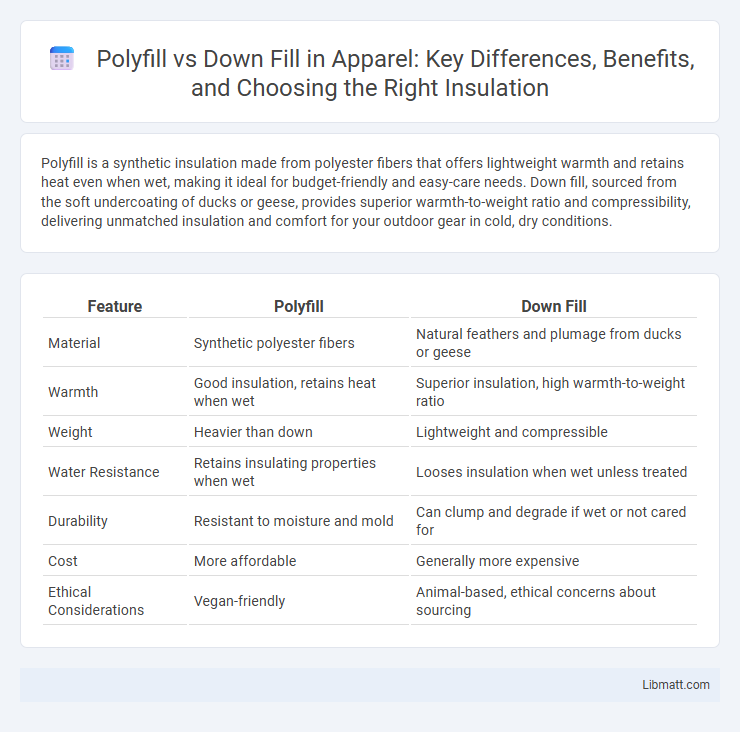Polyfill is a synthetic insulation made from polyester fibers that offers lightweight warmth and retains heat even when wet, making it ideal for budget-friendly and easy-care needs. Down fill, sourced from the soft undercoating of ducks or geese, provides superior warmth-to-weight ratio and compressibility, delivering unmatched insulation and comfort for your outdoor gear in cold, dry conditions.
Table of Comparison
| Feature | Polyfill | Down Fill |
|---|---|---|
| Material | Synthetic polyester fibers | Natural feathers and plumage from ducks or geese |
| Warmth | Good insulation, retains heat when wet | Superior insulation, high warmth-to-weight ratio |
| Weight | Heavier than down | Lightweight and compressible |
| Water Resistance | Retains insulating properties when wet | Looses insulation when wet unless treated |
| Durability | Resistant to moisture and mold | Can clump and degrade if wet or not cared for |
| Cost | More affordable | Generally more expensive |
| Ethical Considerations | Vegan-friendly | Animal-based, ethical concerns about sourcing |
Introduction to Polyfill and Down Fill
Polyfill and down fill are two common types of insulation used in outdoor gear and bedding, each offering unique properties and benefits. Polyfill, made from synthetic fibers, is known for its water resistance, durability, and affordability, maintaining warmth even when damp. Down fill, derived from the plumage of ducks or geese, provides superior warmth-to-weight ratio and compressibility, making it ideal for lightweight and highly insulating applications.
What is Polyfill?
Polyfill refers to synthetic insulation made from polyester fibers designed to mimic the warmth and loft of natural down while offering better moisture resistance and durability. It provides effective thermal insulation in outdoor gear and apparel, especially in wet or damp conditions where down tends to lose its insulating properties. Polyfill materials, such as PrimaLoft or Thinsulate, are lightweight, quick-drying, and often more affordable than natural down alternatives.
What is Down Fill?
Down fill consists of natural feathers from ducks or geese, prized for their superior loft and insulation properties, providing exceptional warmth-to-weight ratio in jackets and bedding. This ultra-light and breathable material traps air efficiently to retain body heat, making it ideal for cold weather conditions. Unlike synthetic polyfill, down fill offers unmatched compressibility and durability, often lasting much longer with proper care.
Key Differences Between Polyfill and Down Fill
Polyfill consists of synthetic fibers designed to mimic the insulating properties of natural down, providing lightweight warmth and water resistance, whereas down fill is made from the soft under feathers of ducks or geese, offering superior loft and natural insulation. Polyfill is typically more affordable, hypoallergenic, and performs better in damp conditions, while down fill excels in insulation-to-weight ratio and breathability but loses effectiveness when wet. The choice between polyfill and down fill hinges on factors such as budget, allergy sensitivity, moisture exposure, and desired warmth-to-weight performance.
Insulation Performance: Polyfill vs Down Fill
Polyfill insulation offers consistent thermal performance by using synthetic fibers that trap air to retain heat, making it reliable in damp conditions where down fill loses loft. Down fill provides superior warmth-to-weight ratio and compressibility, with insulation properties that improve as the fill loft increases, but its performance diminishes when wet. Your choice hinges on balancing moisture resistance and insulation efficiency, where polyfill excels in wet environments and down fill delivers exceptional warmth in dry conditions.
Warmth and Comfort Comparison
Polyfill insulation provides consistent warmth by trapping heat in synthetic fibers that retain loft even when wet, making it ideal for damp conditions. Down fill offers superior warmth-to-weight ratio due to its natural loft and excellent compressibility, providing exceptional comfort in dry, cold environments. Your choice depends on whether you prioritize moisture resistance or maximum insulation efficiency for optimal comfort.
Durability and Longevity
Polyfill insulation offers moderate durability but tends to compress and lose loft over time, reducing its ability to retain heat. Down fill provides superior longevity and resilience due to its natural structure, which maintains loft and insulation even after repeated use and washing. Choosing down fill maximizes the lifespan of your insulated gear, ensuring consistent warmth and performance longer than polyfill alternatives.
Allergies and Hypoallergenic Properties
Polyfill is a synthetic material that is often hypoallergenic, making it suitable for individuals sensitive to allergens, as it resists dust mites and mold. Down fill, derived from the soft under feathers of ducks or geese, can trigger allergies in some people due to natural proteins and dust particles present. Hypoallergenic alternatives to down are sometimes treated or replaced with synthetic options like polyfill to minimize allergic reactions.
Environmental Impact and Sustainability
Polyfill is typically made from synthetic polyester fibers, which are derived from petroleum and less biodegradable, contributing to microplastic pollution. Down fill, sourced from the plumage of ducks or geese, is a natural, renewable material with higher insulation efficiency and longer lifespan, reducing environmental waste. Choosing down fill can enhance your sustainability efforts due to its biodegradability and potential for ethical sourcing through certified standards.
Choosing the Right Fill: Polyfill or Down Fill?
Choosing the right fill depends on your priorities for warmth, weight, and budget; down fill offers superior insulation and compressibility for cold, dry conditions, while polyfill provides water resistance and affordability, ideal for damp or wet environments. Your choice influences durability and care, as down requires more maintenance and performs best when kept dry, whereas polyfill maintains insulation even when wet. Consider your typical activities and climate to select the fill that balances comfort, performance, and cost effectively.
Polyfill vs down fill Infographic

 libmatt.com
libmatt.com